Drawing Restraint 9 (Matthew Barney, 2005)
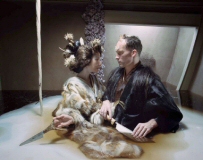 The opening moments of Matthew Barney’s visionary Drawing
Restraint 9 are initially obscure but they ultimately prove to be an
insightful metaphor for the topic of the sculptor/director’s latest magnum
opus. In the film’s first scenes, we watch as a fossil is meticulously wrapped
while a letter of thanks from a Japanese fisherman to General MacArthur is read,
or rather sung, aloud by Will Oldham. Wrapped in the Japanese fashion, where the
presentation of a gift is as important as the gift itself, the fossil’s
transformation into a token of gratitude keys the viewer into an artistic
process wherein the course of creation itself becomes more important than the
end result, which is an impermanent thing at best. That’s not to say that
Barney here finds his art to be useless. It seems to be more a means to an end.
The film, the bulk of which concerns the indoctrination of two Westerners
(played by Barney and Björk) into Japanese culture, is obsessed with process.
It painstakingly details ritual after ritual and one creative progression after
another before finally ending on a transcendent note that is thematically the
result of the duo’s immersion into the country’s whaling culture.
The opening moments of Matthew Barney’s visionary Drawing
Restraint 9 are initially obscure but they ultimately prove to be an
insightful metaphor for the topic of the sculptor/director’s latest magnum
opus. In the film’s first scenes, we watch as a fossil is meticulously wrapped
while a letter of thanks from a Japanese fisherman to General MacArthur is read,
or rather sung, aloud by Will Oldham. Wrapped in the Japanese fashion, where the
presentation of a gift is as important as the gift itself, the fossil’s
transformation into a token of gratitude keys the viewer into an artistic
process wherein the course of creation itself becomes more important than the
end result, which is an impermanent thing at best. That’s not to say that
Barney here finds his art to be useless. It seems to be more a means to an end.
The film, the bulk of which concerns the indoctrination of two Westerners
(played by Barney and Björk) into Japanese culture, is obsessed with process.
It painstakingly details ritual after ritual and one creative progression after
another before finally ending on a transcendent note that is thematically the
result of the duo’s immersion into the country’s whaling culture.
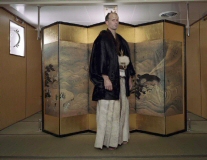 Barney’s constant symbol, an oval bisected by a bar,
reoccurs time and again throughout his work, and Drawing Restraint 9 is
no exception. A symbol of completeness (the oval) being restrained by an
obstacle (the bar), whether creative or physical, the image is one of tension
and is central to DR9’s meaning. Time and again, in different forms,
the viewer watches as the bar of the symbol is peeled away. This gesture
represents the realization of the creative process and the removal of restraint,
which is the central conceit of the Drawing Restraint series of films.
Many of Barney’s other pet metaphors are here as well. As in his Creamaster
saga, DR9 details the physical and mental transformation required to
achieve the creative process. The arduous scenes in which we watch a giant
metallic version of Barney’s icon being constructed on the deck of a whaling
ship highlight the amount of work involved in the creative process. The
symbol’s film-long transformation into an organic, as opposed to manmade,
version of itself underscores the process of metamorphosis that the artist
undergoes.
Barney’s constant symbol, an oval bisected by a bar,
reoccurs time and again throughout his work, and Drawing Restraint 9 is
no exception. A symbol of completeness (the oval) being restrained by an
obstacle (the bar), whether creative or physical, the image is one of tension
and is central to DR9’s meaning. Time and again, in different forms,
the viewer watches as the bar of the symbol is peeled away. This gesture
represents the realization of the creative process and the removal of restraint,
which is the central conceit of the Drawing Restraint series of films.
Many of Barney’s other pet metaphors are here as well. As in his Creamaster
saga, DR9 details the physical and mental transformation required to
achieve the creative process. The arduous scenes in which we watch a giant
metallic version of Barney’s icon being constructed on the deck of a whaling
ship highlight the amount of work involved in the creative process. The
symbol’s film-long transformation into an organic, as opposed to manmade,
version of itself underscores the process of metamorphosis that the artist
undergoes.
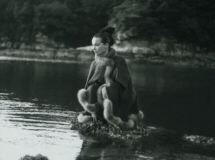 Barney, as a director, seems to have grown somewhat as a
filmmaker since Cremaster 3, his last work. Using a faster cutting rhythm
and more elaborate camera movements throughout, Drawing Restraint 9 is an
easier sit than Barney’s usual output. The thrilling title sequence, which
jumps between the curious procedures of dockworkers and an elaborate Japanese
parade, is a perfect example of montage aesthetics at work. Through the
association of the two events, both become immediately meaningful, and the
propulsive score, which constantly adds layer upon layer to itself, builds the
sense of urgency. As the procession reaches a fever pitch, Barney’s camera
launches into one of the harbor’s smokestacks, switching to a CGI
representation in which the camera is fully immersed into the primordial,
Vaseline-like goo that is one of the sculptor’s foremost obsessions. As the
camera continues plunging downward into the ooze, the figure of a whale becomes
clear, and it is cut by a knife, in a movement that foreshadows the film’s
finale. The significance of this final gesture isn’t initially obvious, but it
fits into the film’s larger context.
Barney, as a director, seems to have grown somewhat as a
filmmaker since Cremaster 3, his last work. Using a faster cutting rhythm
and more elaborate camera movements throughout, Drawing Restraint 9 is an
easier sit than Barney’s usual output. The thrilling title sequence, which
jumps between the curious procedures of dockworkers and an elaborate Japanese
parade, is a perfect example of montage aesthetics at work. Through the
association of the two events, both become immediately meaningful, and the
propulsive score, which constantly adds layer upon layer to itself, builds the
sense of urgency. As the procession reaches a fever pitch, Barney’s camera
launches into one of the harbor’s smokestacks, switching to a CGI
representation in which the camera is fully immersed into the primordial,
Vaseline-like goo that is one of the sculptor’s foremost obsessions. As the
camera continues plunging downward into the ooze, the figure of a whale becomes
clear, and it is cut by a knife, in a movement that foreshadows the film’s
finale. The significance of this final gesture isn’t initially obvious, but it
fits into the film’s larger context.
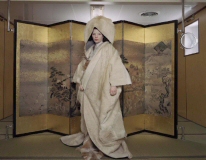 Perhaps more surprising than the resurgence of Barney’s old
ideas in Drawing Restraint 9 (he’s clearly preoccupied with the central
concerns mentioned above), is the ease with which he incorporates his real-life
romantic partner, avant-garde pop-star Björk, into his thematic universe.
Besides composing the film’s impressive score, Björk herself features heavily
in the plot, which becomes a romantic paean to love and mutual development as
she and Barney undergo the process of growth simultaneously. Late in the film,
when Björk and Barney begin slicing one another as part of their transformation
ritual, the scene is decidedly erotic, with distinctly vaginal wounds and
seminal ribbons of blood created by the process. During this scene, Björk’s
vocals inform us that, “from the moment of commitment, nature conspires to
help you,” a statement that clearly has dual meanings of artistic and romantic
devotion. Like anything in Barney’s films, Björk’s history outside of his
film still seems relevant. Her last album was composed entirely of vocals, most
of which stood in for instruments, which fits right into Barney’s conceptual
obsession with the physical obstacles involved in the creation of art. Even some
of the symbolism of Drawing Restraint 9 can be found in Björk’s
previous music videos. Art’s relationship to nature is the subject of her
videos for “Isobel” and “Bachelorette”. The concluding image of DR9
seems an almost explicit nod to her fabulous video for the song “Pagan
Poetry” (a perfectly apt description for Barney’s latest, to be sure). Time
and again in her lyrics, she reminds the listener that people are part of the
unpredictable vortex that we refer to as nature, a notion that is tied into the
Japanese philosophy of “mono no aware” (i.e. a philosophical heightened
awareness of the nature of things), which is central to this work’s outlook.
Perhaps more surprising than the resurgence of Barney’s old
ideas in Drawing Restraint 9 (he’s clearly preoccupied with the central
concerns mentioned above), is the ease with which he incorporates his real-life
romantic partner, avant-garde pop-star Björk, into his thematic universe.
Besides composing the film’s impressive score, Björk herself features heavily
in the plot, which becomes a romantic paean to love and mutual development as
she and Barney undergo the process of growth simultaneously. Late in the film,
when Björk and Barney begin slicing one another as part of their transformation
ritual, the scene is decidedly erotic, with distinctly vaginal wounds and
seminal ribbons of blood created by the process. During this scene, Björk’s
vocals inform us that, “from the moment of commitment, nature conspires to
help you,” a statement that clearly has dual meanings of artistic and romantic
devotion. Like anything in Barney’s films, Björk’s history outside of his
film still seems relevant. Her last album was composed entirely of vocals, most
of which stood in for instruments, which fits right into Barney’s conceptual
obsession with the physical obstacles involved in the creation of art. Even some
of the symbolism of Drawing Restraint 9 can be found in Björk’s
previous music videos. Art’s relationship to nature is the subject of her
videos for “Isobel” and “Bachelorette”. The concluding image of DR9
seems an almost explicit nod to her fabulous video for the song “Pagan
Poetry” (a perfectly apt description for Barney’s latest, to be sure). Time
and again in her lyrics, she reminds the listener that people are part of the
unpredictable vortex that we refer to as nature, a notion that is tied into the
Japanese philosophy of “mono no aware” (i.e. a philosophical heightened
awareness of the nature of things), which is central to this work’s outlook.
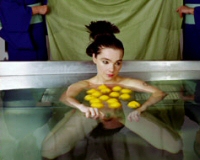 Matthew Barney is a painstaking director whose pieces are
wrought with meaning, and it’s best for those viewing his films for the first
time to approach them with the mindset that literally everything on screen is
loaded with significance. Even if the meanings of objects or sequences aren’t
made readily apparent to the viewer, they should be mentally filed away until
Barney’s grand scheme becomes evident. Despite the accusations of detractors
that he is a willfully obscure charlatan more concerned with his own pretentious
grandeur than any significant message, the thoroughly researched supplemental
materials and soundtracks available to those willing to seek outside the film
suggest otherwise (as does Barney’s own demeanor – at the screening I
attended, he addressed the audience for about ten minutes before the movie began
with background information that clearly was given to allow viewers that might
be intimidated to find an easy way into the film). If anything, his films are
getting easier to digest and more personal as they grow larger. They present
clearer narrative progressions as they increase in scope. That ever-increasing
scope makes his decision to become a filmmaker seem an obvious one. Because film
is a finite medium, by filming and editing shots of his massive instillations,
the passage time becomes another element that this sculptor can control.
Furthermore, because he’s making films instead of sculpture, he’s better
able to direct the viewer through space with his editing techniques, and his
scope is allowed to flourish to encompass real-world locations that no museum
could contain.
Matthew Barney is a painstaking director whose pieces are
wrought with meaning, and it’s best for those viewing his films for the first
time to approach them with the mindset that literally everything on screen is
loaded with significance. Even if the meanings of objects or sequences aren’t
made readily apparent to the viewer, they should be mentally filed away until
Barney’s grand scheme becomes evident. Despite the accusations of detractors
that he is a willfully obscure charlatan more concerned with his own pretentious
grandeur than any significant message, the thoroughly researched supplemental
materials and soundtracks available to those willing to seek outside the film
suggest otherwise (as does Barney’s own demeanor – at the screening I
attended, he addressed the audience for about ten minutes before the movie began
with background information that clearly was given to allow viewers that might
be intimidated to find an easy way into the film). If anything, his films are
getting easier to digest and more personal as they grow larger. They present
clearer narrative progressions as they increase in scope. That ever-increasing
scope makes his decision to become a filmmaker seem an obvious one. Because film
is a finite medium, by filming and editing shots of his massive instillations,
the passage time becomes another element that this sculptor can control.
Furthermore, because he’s making films instead of sculpture, he’s better
able to direct the viewer through space with his editing techniques, and his
scope is allowed to flourish to encompass real-world locations that no museum
could contain.
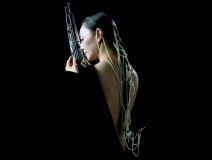 At this point, Barney seems to have progressed as a creator
to the point where I have learned as a viewer to give him my trust until the
film plays out. The film’s tea sequence, which lasts about twenty protracted
minutes long, initially seemed to be a misstep to me, mistaking decorum and
adherence to ritual for the process of transformation through creation. In
retrospect, its seemingly overlong presentation feels like a fitting
illustration of the mode of restraint being examined here. Just as in the
previous Drawing Restraint films, self-imposed restriction is
being observed as a creative conduit. Specifically, in DR9 submergence in
Japan’s emotionally and physically muted (consider Bjork’s tight-fitting
kimono or the personality-draining ornamental haircuts that the two are
subjected to) culture and rituals is the restraint. This is not to be confused
with the creative process itself. Rather, it’s part of the deconstruction of
self that Barney deems necessary to grow. It seems that this growth is the true
function of art in Barney’s eyes. Personal growth of the artist, against any
preconceived boundaries of self, is far more important than any end product. The
thrilling, intensely beautiful Drawing Restraint 9 certainly argues that
Barney’s end product, which skillfully conveys its creator’s process, is
nothing to sneeze at either.
At this point, Barney seems to have progressed as a creator
to the point where I have learned as a viewer to give him my trust until the
film plays out. The film’s tea sequence, which lasts about twenty protracted
minutes long, initially seemed to be a misstep to me, mistaking decorum and
adherence to ritual for the process of transformation through creation. In
retrospect, its seemingly overlong presentation feels like a fitting
illustration of the mode of restraint being examined here. Just as in the
previous Drawing Restraint films, self-imposed restriction is
being observed as a creative conduit. Specifically, in DR9 submergence in
Japan’s emotionally and physically muted (consider Bjork’s tight-fitting
kimono or the personality-draining ornamental haircuts that the two are
subjected to) culture and rituals is the restraint. This is not to be confused
with the creative process itself. Rather, it’s part of the deconstruction of
self that Barney deems necessary to grow. It seems that this growth is the true
function of art in Barney’s eyes. Personal growth of the artist, against any
preconceived boundaries of self, is far more important than any end product. The
thrilling, intensely beautiful Drawing Restraint 9 certainly argues that
Barney’s end product, which skillfully conveys its creator’s process, is
nothing to sneeze at either.
75
09.20.05
Jeremy Heilman